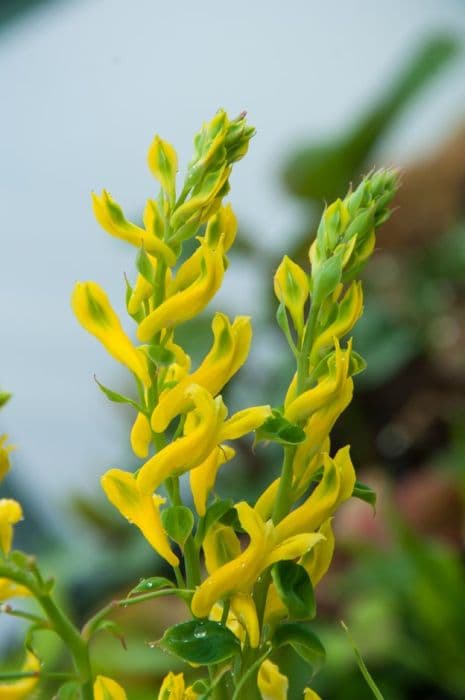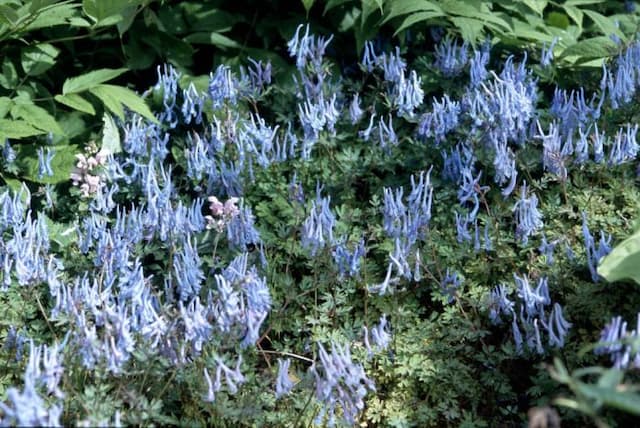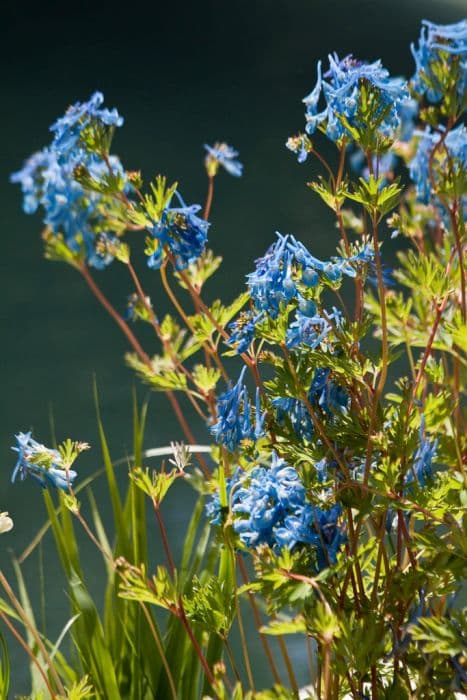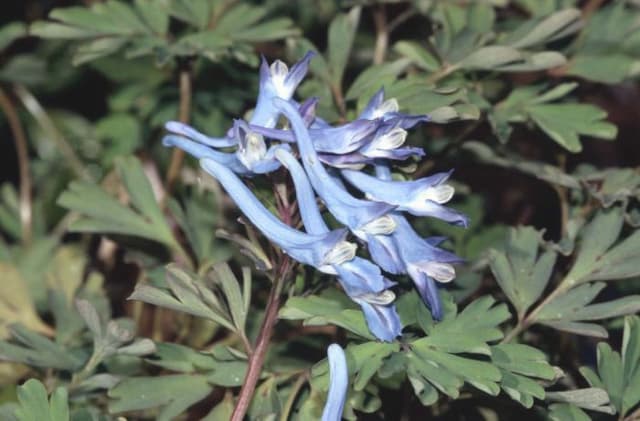Blue Poppy Meconopsis (Fertile Blue Group) 'Cally Lingholm'

ABOUT
'Cally Lingholm' is a part of the Fertile Blue Group of the Himalayan blue poppy. This particular variant is admired for its striking, large, blue flowers that display a captivating shade of sky to cobalt blue. The petals are delicate and satiny, with a slightly crinkled texture, encircling a central group of prominent, golden-yellow stamens that create a beautiful contrast with the blue petals. The plant has a clump-forming habit, with foliage that is an attractive green color. The leaves are hairy and deeply lobed, forming a lush, textured backdrop for the blossoms. The overall appearance of 'Cally Lingholm' exudes a sense of exotic allure and rarity, making it a highly sought-after plant for ornamental gardens, where it can provide a stunning splash of color during its blooming season. The Himalayan blue poppy, in general, is known for its ephemeral but memorable display, and 'Cally Lingholm' lives up to this reputation with its exceptional beauty.
About this plant
 Names
NamesSynonyms
Blue Poppy, Himalayan Blue Poppy, Tibetan Blue Poppy.
Common names
Meconopsis (Fertile Blue Group) 'Cally Lingholm'.
 Toxicity
ToxicityTo humans
Blue poppy (Meconopsis) is not known to be toxic to humans. There is no well-documented evidence of toxicity from consuming any parts of the blue poppy and no commonly recognized symptoms of poisoning. Therefore, accidental ingestion of this plant is not expected to cause harm or significant health issues.
To pets
Blue poppy (Meconopsis) is not known to be toxic to pets. It is not listed among the common toxic plants for animals such as dogs and cats, and there are no widely reported symptoms of poisoning or adverse health effects resulting from its ingestion by pets. Thus, it is not considered dangerous if pets happen to consume parts of this plant.
 Characteristics
CharacteristicsLife cycle
Perennials
Foliage type
Deciduous
Color of leaves
Green
Flower color
Blue
Height
2-3 feet (60-90 cm)
Spread
1-2 feet (30-60 cm)
Plant type
Herb
Hardiness zones
5
Native area
Himalayas
Benefits
 General Benefits
General Benefits- Ornamental Value: Meconopsis 'Cally Lingholm' is highly prized for its striking blue flowers, which add a vivid splash of color to any garden, enhancing its aesthetic appeal.
- Wildlife Attraction: The vibrant blooms can attract pollinators such as bees and butterflies, encouraging biodiversity within the garden environment.
- Emotional Wellbeing: The beauty of the sky-blue poppy flowers can have a calming effect and improve the emotional wellbeing of those who spend time in their presence.
- Shade Tolerance: This plant is well-suited for shaded areas, making it an ideal choice for adding color to parts of the garden where other flowers might not thrive.
- Cool Climate Adaptation: Meconopsis 'Cally Lingholm' is adapted to cooler climates, filling a niche in garden ecosystems that warmer climate plants cannot.
- Cultural Significance: The remarkable blue poppy holds a special allure and often features in gardening shows and publications, making it a conversation piece for garden enthusiasts.
- Seasonal Interest: As a perennial, Meconopsis 'Cally Lingholm' offers seasonal interest with its flowering in late spring to early summer, providing a yearly spectacle.
- Garden Variability: This plant can act as both a focal point and a complement to other plants, allowing for versatile garden designs and plant combinations.
 Medical Properties
Medical PropertiesThis plant is not used for medical purposes.
 Air-purifying Qualities
Air-purifying QualitiesThis plant is not specifically known for air purifying qualities.
 Other Uses
Other Uses- Photography subject: Meconopsis, with its stunning blue flowers, is often used by photographers to create beautiful images and is highly appreciated in macro photography.
- Artistic inspiration: The vibrant color and delicate structure of Meconopsis flowers are commonly used by artists for botanical illustrations and paintings.
- Educational tool: Botanical gardens and educational institutions may use Meconopsis plants to teach about the unique flora of the Himalayas and plant biology.
- Motif in design: The distinct shape and color of Meconopsis flowers can serve as a motif for designers in textiles, wallpaper, and home decor.
- Ecological indicator: Due to its preference for specific conditions, the presence of Meconopsis can indicate a healthy, undisturbed ecosystem.
- Bee forage: Meconopsis flowers can attract bees and other pollinators, providing an important source of nectar.
- Cultural symbol: In certain cultures, Meconopsis can symbolize resilience and endurance, as they grow at high altitudes and in tough conditions.
- Garden biodiversity: Planting Meconopsis can contribute to the biodiversity of a garden, providing habitat for various insects and birds.
- Color dye: Historically, the vibrant petals of certain Meconopsis species may have been used to create natural dyes for fabrics, though this is less common today.
- Seasonal celebrations: In some regions, the blooming of Meconopsis can coincide with cultural festivals, making it a part of seasonal decorations and celebrations.
Interesting Facts
 Feng Shui
Feng ShuiThe Blue Poppy is not used in Feng Shui practice.
 Zodiac Sign Compitability
Zodiac Sign CompitabilityThe Blue Poppy is not used in astrology practice.
 Plant Symbolism
Plant Symbolism- Rarity: Blue poppies are known for being rare and difficult to cultivate, symbolizing the unique and rare beauty in life.
- Achievement: Due to the challenge of growing them successfully, they can represent success and the achievement of difficult goals.
- Tranquility: The serene blue of the Blue poppy is often associated with calmness and peacefulness.
- Mystery: The ethereal appearance of the Blue poppy can signify mystery and the unknown.
- Dreams: The dream-like quality of the flower might symbolize imagination and the pursuit of dreams.
 Water
WaterHimalayan Blue Poppy prefers consistent moisture and should be watered thoroughly once the top inch of soil feels dry to the touch, typically once or twice a week depending on weather conditions. Provide enough water to ensure moisture reaches the root zone, using around 1 to 1.5 gallons per watering session for an established plant. During hot, dry spells, watering frequency may increase, and during cooler, wet periods, it will decrease. It's crucial to avoid waterlogging as these plants dislike sitting in wet soil, so ensure good drainage.
 Light
LightHimalayan Blue Poppy thrives best in partial shade or a spot that provides shelter from the intense afternoon sun. They prefer a location with bright, indirect light or dappled sunlight for much of the day. Avoid full sun locations, as it can lead to scorching of the leaves and stress the plant, potentially causing poor growth and flowering.
 Temperature
TemperatureHimalayan Blue Poppy prefers cooler conditions and thrives in temperatures ranging between 50°F and 70°F. It can tolerate a minimum temperature down to around 20°F but should be protected from harsh frosts. Extreme heat above 80°F can be detrimental to the plant, so during summer, ensure it's placed in a cooler, shaded position.
 Pruning
PruningPruning of Himalayan Blue Poppy is usually done to remove spent flower stalks after blooming, which encourages more flowers and prevents the plant from spending energy on seed production. Deadheading should be carried out as soon as the flowers fade, and general tidying of dead or yellowing leaves can be done as needed throughout the growing season to maintain plant health and appearance.
 Cleaning
CleaningAs needed
 Soil
SoilThe Himalayan Blue Poppy prefers a soil mix that is rich in organic matter, part loamy and part gritty for excellent drainage, and consistently moist. A slightly acidic to neutral pH of 6.0 to 7.0 is suitable for this plant. Adding leaf mold or composted bark can enrich the soil, and a layer of mulch helps retain soil moisture.
 Repotting
RepottingHimalayan Blue Poppies do not require frequent repotting and may be sensitive to disturbance. They should be repotted every 2 to 3 years, or when the plant outgrows its container, ensuring minimal root disturbance during the process.
 Humidity & Misting
Humidity & MistingHimalayan Blue Poppies thrive in conditions with high humidity. The best humidity level for these plants is maintained around 60-80%. They enjoy a cool and moist environment, representative of their native mountainous habitats.
 Suitable locations
Suitable locationsIndoor
Ensure cool temps, indirect light, moist, acidic soil.
Outdoor
Plant in dappled shade, moist, well-draining, acidic soil.
Hardiness zone
5-7 USDA
 Life cycle
Life cycleThe Meconopsis 'Cally Lingholm', commonly known as the Blue Poppy, begins its life as a seed, requiring cold stratification to trigger germination. Once conditions are favorable, typically in early spring, the seed germinates and a small seedling emerges, growing into a rosette of leaves close to the ground. As the plant matures, it develops a flowering stalk, which can reach up to 1 meter in height, crowned with large, vivid blue flowers that bloom usually in late spring to early summer. After pollination, which is often carried out by bees, the flowers produce capsules containing numerous tiny seeds. These seeds are then dispersed by wind or through manual collection for propagation. The Blue Poppy is a perennial plant, and after flowering, it may die back to its root system where it becomes dormant before re-sprouting the following season, thus completing its life cycle.
 Propogation
PropogationPropogation time
Spring to early summer
The most popular method for propagating Meconopsis 'Cally Lingholm', commonly known as Himalayan blue poppy, is by sowing seeds. Seeds should be sown in late winter to early spring in a cold frame or similarly protected environment. The seeds are very fine, so it is crucial to handle them with care and sow them on the surface of a well-draining seed starting mix. They require light to germinate, so they should not be covered with soil but can be gently pressed into the substrate. The seed tray must be kept moist and in a cool position, as too much warmth can prevent germination. Germination is often erratic, so patience is key. Seedlings can then be transplanted into individual pots when they are large enough to handle and eventually moved to their final position in the garden once the risk of frost has passed.









